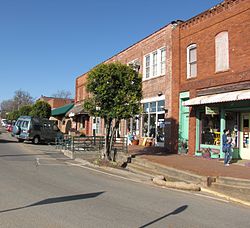Pittsboro, North Carolina | |
|---|---|
Town | |
 Hillsboro Street in downtown Pittsboro | |
| Nickname: Circle City | |
 Location of Pittsboro, North Carolina | |
| Coordinates: 35°43′40″N79°10′10″W / 35.72778°N 79.16944°W | |
| Country | United States |
| State | North Carolina |
| County | Chatham |
| Government | |
| • Mayor | Kyle Shipp |
| Area | |
• Total | 5.52 sq mi (14.29 km2) |
| • Land | 5.49 sq mi (14.21 km2) |
| • Water | 0.03 sq mi (0.08 km2) |
| Elevation | 466 ft (142 m) |
| Population (2020) | |
• Total | 4,537 |
| • Density | 826.86/sq mi (319.24/km2) |
| Time zone | UTC-5 (Eastern (EST)) |
| • Summer (DST) | UTC-4 (EDT) |
| ZIP codes | 27228, 27312 |
| Area code | 919 / 984 |
| FIPS code | 37-52660 [3] |
| GNIS feature ID | 2407130 [2] |
| Website | pittsboronc |
Pittsboro is a town in and the county seat of Chatham County, North Carolina, United States. [4] The population was 3,743 at the 2010 census [5] and 4,537 at the 2020 census.
Contents
- History
- Foundation and early years
- Slavery and racial segregation
- Early industrialization
- Chatham County Courthouse fire
- City government
- Educational facilities
- Media outlets
- Geography
- Demographics
- 2020 Census
- 2010 Census
- 2000 Census
- Economy
- National Register of Historic Places listings
- Notable people
- Miscellaneous
- See also
- References
- Further reading
- External links
The town was established in the late 18th century, shortly after the American Revolution, as the county seat for the newly formed Chatham County. In the years leading up to the American Civil War, the economy was dominated by small-scale farms that relied heavily on enslaved labor. In the aftermath of the civil war, racial tensions were high, and the town was noted for a number of lynchings and other racial violence in the late 19th century. Industrialization came to the community in the late 19th century, as a number of rivers cross the area providing locations for mills and factories. Economic and population growth would continue into and throughout the 20th century. As industry moved away from the community, it has in the 21st century transitioned into a bedroom community for the nearby cities of the Research Triangle region.



